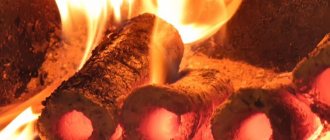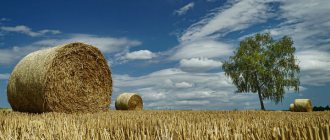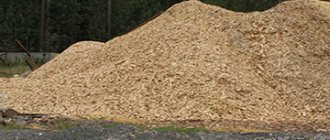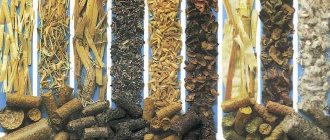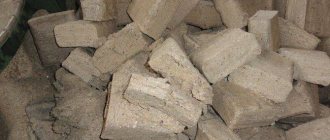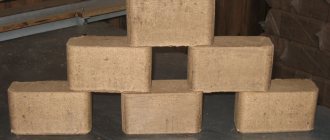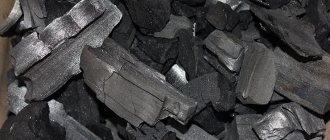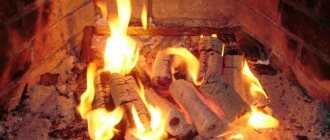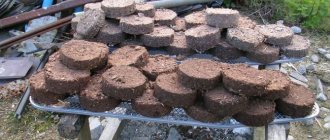Fuel briquettes, also known as Euro-firewood, are today a successful alternative to firewood and coal. Affordability, versatility and other advantages make them an excellent type of solid fuel. They are actively used both for stoves and boilers, and for fireplaces. In this article I want to talk about wood fuel briquettes, and also mention peat analogues.
Fuel briquettes
BUY FUEL BRIQUETTES
How are fuel briquettes produced?
The raw material for this type of fuel is wood processing industry waste. In addition, peat and straw are also used as materials due to their energy value. No glue is used in production; the briquettes contain no foreign binders.
However, the “bricks” hold their shape well and remain hard. At the beginning, the raw material is crushed, which allows it to be effectively dried and then compressed. When sawdust is heated, a natural substance is released - lignin. It is this that allows the wood particles to be bonded together during pressing. It is absolutely safe for humans and the environment. Thanks to lignin, Euro firewood is produced without additional gluing components.
Advantages of fuel briquettes
If we compare fuel briquettes with the firewood we are used to, we cannot help but note the following advantages of the former:
- High combustion temperature. Firewood burns on average 2 times weaker than fuel briquettes. This is due to their high humidity (about 15-20% subject to storage conditions) and low density. Therefore, their calorific value is significantly lower: approximately 2500 kcal/kg versus 4500-5000 kcal/kg, which are produced when burning briquettes. The latter undergo not only thorough drying, leaving only 5-8% moisture, but also pressing. The combination of high density and low humidity gives briquettes a higher combustion temperature.
- Uniform and long burning. Surely everyone who has burned ordinary wood has noticed the following drawback: a decrease in heat transfer during combustion. In comparison, fuel briquettes burn 3 times longer, while constantly releasing heat. Thanks to such uniformity and long burning, briquettes are consumed much more economically.
- Safe for the environment and humans. Fuel briquettes are produced from waste, which will be a plus for those who care about the environment. At the same time, when burning, they emit little smoke, almost no smell and do not spark. They leave little soot behind, making cleaning faster and easier.
- Compact. Euro firewood is really easy to store, as it has a standard shape and small size. Unlike coal and firewood, each batch of briquettes is similar in size to the previous one. Despite their considerable weight (from 10 kg per package), these “bricks” are quite compact.
Fuel briquettes are compact
About firing stoves
Fuel briquettes are suitable for heating any stoves. The calorific value of briquettes, which is 4200 kcal/kg, allows you to heat stoves much faster. Resin-free briquettes protect the chimney and gas pipes from the appearance of soot. Briquettes have very low ash content - only 0.5–1%. After the briquettes burn, a little ash remains, not coals. The furnace firebox is practically free of clutter, and the maintenance and cleaning interval increases several times. When burned, briquettes emit carbon monoxide 50 times less than coal and 10 times less than natural gas. It is easier to melt briquettes, for example using paper, twigs or lighter fluid.
Disadvantages of fuel briquettes
Of course, fuel briquettes cannot be perfect for every user. They also have their disadvantages in comparison with the same coal or firewood.
- Lack of moisture resistance. Euro firewood is afraid of water and crumbles when exposed to moisture. When opening the original packaging, you should immediately make sure that the fuel is stored in a dry place where it is not humid.
- They take a long time to flare up. Unlike firewood, briquettes need time to ignite and begin to give off heat. Therefore, it will not be possible to warm up the room quickly with them.
- Not so aesthetically pleasing. We are talking about the cozy crackling of burning wood and the beautiful flame in the fireplace. Fuel briquettes do not burn as beautifully. This is not such a significant minus in comparison with the previous ones, but it is also worth taking into account.
Why Eurowood is gaining popularity
When deciding to use a gas system for heating, a number of problems arise that not everyone can solve. But the upcoming disadvantages cannot be ignored. To ensure proper operation of a gas boiler, it is necessary to have a uniform, constant supply of electricity, as well as quite a lot of funds. For the safe operation of this system, it is also necessary to build a chimney in the room to remove unnecessary gases, but the room itself should be regularly ventilated. Not every such boiler can survive harsh winters, so when purchasing it is important to consider the degree of frost resistance.
If we talk about wood heating, it requires a large amount of material due to its low efficiency. When using this method, a lot of wood is wasted, as a result of which nature suffers. Firewood also needs to be stored well, otherwise nothing will come out of raw or rotten raw materials. A person without experience may not be able to cope with such a task, so some even resort to the help of a stoker and a firewood harvester.
Coal heating requires the use of high-quality raw materials, for which a lot of money has to be allocated. Maintenance of a heating installation includes many stages of dirty work: you need to remove soot, ash, and soot. The use of coal leaves a lot of black dust, which can make it very difficult to keep your home clean.
As you can see, although all these methods have their positive sides, they entail many significant disadvantages that we would like to avoid.
To avoid such difficulties, you can use fuel briquettes. At the moment, there are not many factories producing eco-wood in the Russian Federation, but this material is becoming popular. This can be explained by the fact that the effect of its use comes faster, so the consumption of raw materials is lower.
A little about the cost
At first glance, it may seem that fuel briquettes are unprofitable from a financial point of view in comparison with firewood. The cost of the same weight of these types of fuel varies almost twice, and not in favor of briquettes. However, it is worth considering that one batch may contain firewood of different quality, including high humidity and porosity.
Thanks to the manufacturing technology, each briquette in the package has the same density, and its moisture content is no more than 9%. On average, 1 cubic meter of briquettes is equal to 4-5 cubic meters of the same birch firewood. Therefore, they are more profitable both in terms of characteristics and price.
Fuel briquettes burn for a long time and with high quality
Coniferous or birch?
At the end, any European firewood has approximately the same density, regardless of the wood species used. Oak briquettes have a higher rate. However, this does not mean that they are necessarily better in quality.
Since conifers are not as dense, it is easier to make fuel briquettes from them. The production cost is lower, which allows you to sell European firewood at a lower cost. Therefore, pine briquettes are often slightly cheaper than their birch and oak counterparts.
It is believed that such European firewood burns better and cleaner due to the resins they contain. Their heat transfer rate is slightly higher, that is, they produce more heat. However, the ash content of this option is higher. The ash does not burn, but remains in the oven. Chimney maintenance when using pine briquettes should be more thorough. This is all due to the above-mentioned resins and ash, which do not burn completely, but remain on the bottom and walls of the furnace.
Unlike their coniferous counterpart, hardwood briquettes contain less ash, and therefore there are fewer by-products from them. They leave no ash behind, no unpleasant odor, and the chimney remains clean longer.
At the same time, it will not be possible to detect any significant difference in the calorific value of coniferous and hardwood briquettes. Therefore, you should rely solely on your preferences and willingness to more carefully monitor the condition of the stove.
What types of briquettes and pellets are there?
- Woody. To create this raw material, only wood waste is used - sawdust, shavings, branches, sawdust, so the cost does not depend on the type of wood. Most often, birch, oak and pine needles are used in production.
- Peat. The main disadvantage in operation is the large amount of soot. Therefore, such briquettes require certain ovens.
- Straw. In terms of cost, this is the cheapest type. Not much heat comes out, but a lot of ash remains.
- From the shell. This is a high quality material, but not that common yet. Although it is expensive, it burns beautifully. Can be safely used for fireplaces.
- From the husk. They produce the most heat than others, but during the combustion process they produce soot, so it is necessary to clean the chimney regularly. The highest temperature raw material is sunflower shell pellets.
A little about peat fuel briquettes
Peat washers for heating
Peat is an environmentally friendly and safe material for the production of fuel briquettes. Manufacturers choose low-grade peat, which has virtually no foreign impurities. When such material burns, there are no sparks and no toxic substances are released.
Peat briquettes are able to retain their combustible properties for many years. Like their wood counterpart, it is best to keep them away from moisture. Made in the form of neat bricks or washers, they, like Euro firewood, take up fairly little space and are easy to transport.
Peat briquettes for heating
At first glance, it may seem that peat briquettes for heating are more expensive than birch firewood. However, the calorific value of this material is much higher than that of firewood, so for the same room you will need fewer briquettes than logs.
High flammability can also be considered a disadvantage rather than an advantage. Yes, peat briquettes flare up easily and begin to give off heat faster, but it is more difficult to extinguish such a flame. Therefore, you should immediately think about the safe storage of this option.
Fuel briquettes Ruf
The German brand Ruf has been offering its fuel briquettes for sale for a long time. High quality raw materials and proven technology allow us not to doubt the manufacturer. Ruf does not use harmful chemicals or bark in its production. Briquettes of this brand burn well, are stored for a long time and have a standard small brick shape. There are both Ruf coniferous and birch briquettes to choose from.
Coniferous briquettes Ruf
Fuel briquettes Pini kay
Pini kay birch briquettes are commonly called Euro firewood. They are made using a different technology. Unlike the previous manufacturer, which uses a hydraulic press and classic drying, Pini kay uses screw pressing. The wood is crushed and heated to a high temperature and then forced into an extruder. Thanks to firing and high pressure, the output produces fuel briquettes in the form of a polyhedron with a hole in the middle. Very hard and having no more than 0.1% ash content, they flare up quickly and can even be used for a fire or fireplace.
Eurofirewood Pini kay
In conclusion, I would like to say that fuel briquettes are an excellent heating solution! Convenient to transport and safe in composition, they are able to warm up rooms for a long time and efficiently, leaving behind a minimum of waste. They are convenient to store due to their compactness, and in our online store you can choose the ideal option for fuel briquettes made of wood or peat.
And may you always be warm!
Your Kuzmich.
Conclusion
Thanks to modern technologies, we can use alternative fuel - briquettes. These are compressed particles of various materials. The most common briquettes are made from sawdust, but similar products can be purchased from straw, peat or coal.
With the help of fuel briquettes you can heat a bathhouse, a summer house and a private house. Their main advantages are environmental friendliness and high heat transfer at an affordable price. Disadvantages include the long time it takes to ignite the fuel and the pungent smell of ash, which is uncharacteristic of firewood.
